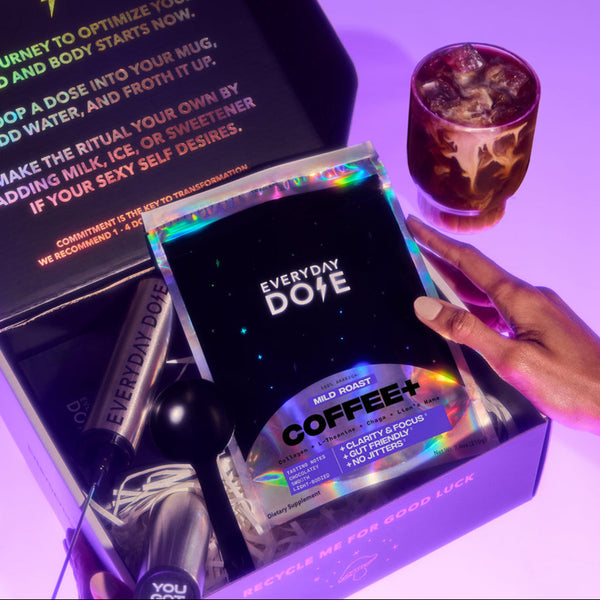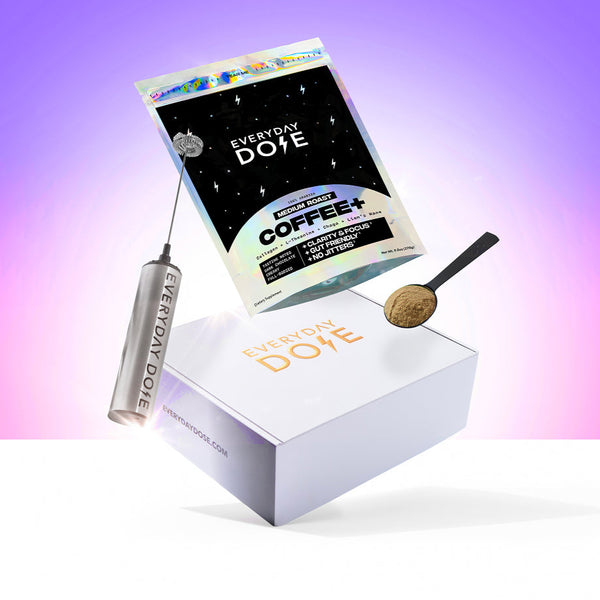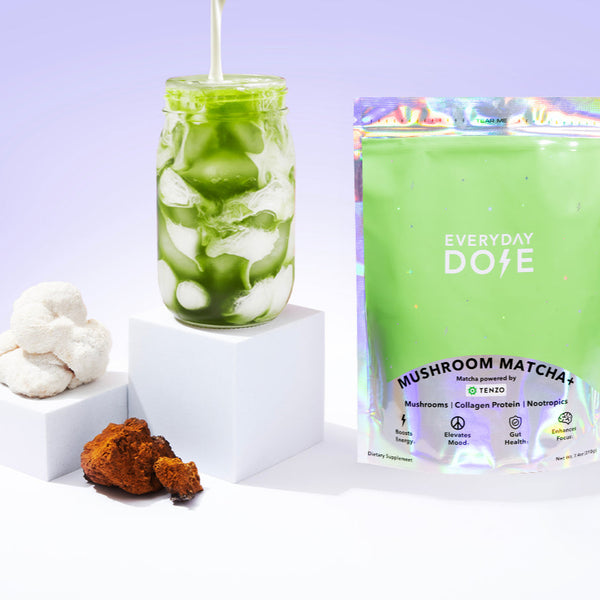How To Reduce Acid in Coffee

Is there anything like a well-made cup of coffee? When it’s brewed perfectly, you can really taste the delicate flavor notes like caramel, plum, or citrus. However, when the coffee leans a little more toward the acidic side, it can be all you taste. And no one likes a cup of battery acid on a Monday morning.
Luckily, even if you sleep in and accidentally make your cup too acidic, there are things you can do to help. Here are 10 ways you can reduce acid in your coffee.
What Makes Coffee Acidic?
When we say coffee is “acidic,” we don’t mean it’s going to melt a hole in your cup. On the taste side, “acidity” refers to that bright, tangy, sometimes citrusy kick you get in certain brews. It’s what gives your favorite light roast those snappy, fruit-forward notes.
That being said, most coffee clocks in around pH 4.85 to 5.10, which puts it squarely in the mildly acidic zone. It’s less intense than orange juice but more zesty than plain water.
For most people, this is NBD. But for coffee lovers with acid reflux, GERD, or sensitive stomachs, this pH can cause heartburn and nausea. Studies suggest that compounds like chlorogenic acids and quinic acid — which are naturally occurring in coffee — can irritate the gut lining or trigger symptoms in those prone to acid sensitivity.
How To Reduce Acid in Coffee: 10 Ways
If you’ve already made an acidic cuppa, there’s only so much you can do to fix that. Most of these methods revolve around preventing acidity in the first place. However, there’s a fix for every stage of a coffee fiasco, and we’ll go through them all.
1. Go With Arabica
Most of the coffee you sip comes from two main types of coffee plants: Arabica and Robusta. Arabica beans typically have a lower caffeine content and lower acidity than Robusta, with a sweeter, more nuanced flavor profile. It can be floral, fruity, sometimes chocolatey.
Robusta, on the other hand, has more chlorogenic acids, the very culprits linked to increased acidity and bitterness. It also has nearly double the caffeine. And while that might sound like a perk at 6 a.m., it’s not so great if your stomach feels like it’s doing cartwheels after every cup.
So, if you’re aiming for a smoother brew, Arabica beans might be your best option. That’s why we use 100% Arabica beans in our coffee blends.
2. Choose a Darker Roast
If you thought the biggest thing roast affects is flavor, think again. Roast level also plays a major role when it comes to coffee acidity.
Light roasts retain more of the coffee’s natural acids, including those chlorogenic compounds we talked about. That’s why a light roast from Ethiopia tastes like lemons on a summer vacation. Sure, it’s bright and lively, but it might also be a little too acidic for some folks.
3. Pick a Mellow Origin
Coffee beans are like wine grapes. They reflect the soil, climate, and altitude where they grow. Known as “terroir,” these conditions can affect how acidic your coffee ends up.
In general, high-altitude coffee from places like Ethiopia or Kenya tends to be more acidic. This is because the cooler temps slow the bean’s growth, letting sugars and acids develop more fully. That means a more complex, acidic cup. It’s great for coffee competitions, maybe not for your acid reflux.
4. Pick a Low-Acid Coffee
You don’t have to give up coffee to stop getting unwelcome heartburn. Low-acid coffee is real, delicious, and tastes just like your regular cup — just without the drama.
And if you want the best of both worlds, try our Mushroom Coffee. Our brew uses a proprietary low-acid extraction process, which keeps all the flavor and perks of coffee minus the stomach-wrecking acids.
It also contains some other magical ingredients. L-theanine (sourced from tea) helps smooth out the jittery effects of caffeine, so you get alertness without anxiety. Lion’s Mane supports focus and gut health, while Chaga provides extra antioxidants. Finally, it contains collagen, which can help your skin glow and your gut stay happy.
5. Try Cold Brew
When you brew coffee with cold water over a long period (usually 12 to 24 hours), you extract fewer of the acidic compounds that are more soluble in hot water, like chlorogenic and quinic acids. This results in a brew that’s way less acidic. Plus, cold brew tends to highlight the coffee’s natural sweetness and chocolatey notes.
6. Use a Coarser Grind
Grind size isn’t just a technicality — it also affects the overall flavor of your cup. Using a coarser grind can lead to a less acidic brew, especially when combined with longer extraction times (we’ll get to that next).
Finer grounds increase surface area, meaning more rapid extraction of acids and caffeine. A coarse grind slows things down, which can result in a more balanced, mellow cup.
It also reduces the risk of over-extraction, where too many acids and bitter compounds are pulled into your mug. So, the next time you’re setting your grinder, think beach sand — not powdered sugar.
7. Try a Filter Brewing Method
Using a filter brewing method can help lower the acid load in your cup. These include methods like pour-over, drip coffee, and even an old-school coffee maker.
Paper filters trap some of the coffee oils and fine particles that carry bitter and acidic compounds. That means your final brew ends up smoother, cleaner, and a touch easier on the gut. I
8. Increase Brewing Time
It might sound counterintuitive, but giving your coffee more time to steep — especially at lower temps — can actually reduce acidity. This is especially true for cold brew and French press methods.
The key is controlled extraction. With more time, you're able to balance the extraction of acids with sweeter and fuller-bodied compounds, smoothing out any sour or sharp edges. Extending brew time, especially with immersion methods, can also contribute to more even flavor development.
9. Add Some Milk…
Adding milk or a non-dairy alternative with calcium can help neutralize some of the acids in your coffee. Milk contains casein proteins and calcium, which naturally buffer acidity and smooth out your brew’s flavor profile.
This won’t make your coffee pH-neutral, but it does reduce the perceived acidity on your palate and in your digestive tract. In fact, dairy can also help coat the stomach lining, making it less vulnerable to irritation from acidic compounds like chlorogenic acids.
10. …Or Some Baking Soda!
A pinch (and we mean a tiny one) of baking soda can go a long way in reducing coffee’s acidity. Baking soda, or sodium bicarbonate, is an alkaline compound that can help neutralize excess stomach acid and mildly raise the pH of your coffee. It’s especially helpful if you accidentally over-roasted your beans or made a brew that tastes like it could strip paint.
Use just ⅛ teaspoon or less per cup to avoid altering the flavor too much. It won’t turn your coffee into a health tonic, but it might make it gentler on your gut.
The Bottom Line
You don’t have to choose between your love for coffee and your love for smooth digestion. By choosing the right beans, trying new brewing methods, and adding some milk, you can enjoy every sip without the acid backlash.
Or, you could skip the hassle and opt for our mushroom blends, which are specifically formulated to be low in acid. We know the struggle because we’ve been there, and our goal is to make it as easy as possible for you to avoid the negative side effects that can come with regular coffee. To learn more about how we do that, check out the Everyday Dose blog today.
Sources:
Can Coffee Cause Gastritis? | Allied Digestive Health
Influence of Various Factors on Caffeine Content in Coffee Brews | PMC
Does Coffee Have Terroir and How Should It Be Assessed? | PMC
Cow Milk Can Protect the Gut from Alcohol-Induced Gastric Ulcers | IMGC
Start your day
The Right Way








